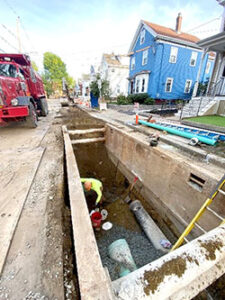
City staff conducted a virtual public meeting last week, providing updates and fielding questions by the public concerning the current and future state of the Spring Hill Sewer Separation project.
By Ryan DiLello
On Wednesday, November 9, the city held a virtual meeting to review the Spring Hill Sewer Separation project. Over 50 residents attended to receive updates on the project and to ask its project managers questions about the local impacts of the construction. For a detailed look at updates by the street, and to hear all the community’s questions, you can view the video at https://www.youtube.com/watch?v=2n9uwcKCDUg (or on the Somerville GovTV).
Jesse Moos, Construction Liaison to the city and Dan Amelin, Project Manager, co-led the meeting. Moos provided some background to the teams involved in the sewer work, naming P. Gioioso & Sons as the general contractor, Stantec Consulting as designers, and Hatch Associates green infrastructure planners.
The project will address issues across five areas of infrastructure: drainage, sewage, green stormwater management and trees, and mobility. “Prior to the start of this project, everyone within the designated area was living with 140-year-old utility systems – time for an upgrade.” said Amelin.
Drainage and sewage improvements are currently underway. Surface work within the realm of green infrastructure and mobility is expected to begin in the late spring of 2023. Green infrastructure improvements will include stormwater tree trenches, curb irrigation ways, and bioretention basins. Updates to mobility will include new sidewalks, curb bumpouts, new separated bike lanes, and speed bumps.
The project will impact trees in the area. Amelin shared that the city has excavated 15 of the 25 trees slated for removal, but there are plans to plant 185 additional trees around the affected areas.
Following street-by-street project updates, Amelin launched into an FAQ section sourced from residents, constituents and counselors. The FAQ was broken into three categories.
What is a temporary water bypass? Why am I connected?
“This is a blue pipe you might have seen connected to your house,” Amelin said. “You are connected because they de-energize the existing main so they can either remove sections or replace it in full with brand new pipe. The process to connect each building or home to a water bypass – typically our contractor will connect that plastic blue hose to a spigot and backfeed your house while they take the existing main out of service. More often than not, that means they bypass the water meter on your house,” Amelin said.
How does this affect my water bill?
With the disclaimer that the water department knows more, Amelin said the department tends to charge residents an approximate rate based on their usage in the same month during the previous year. Amelin recommended contacting the water department for further details.
Why is water flowing from a hose down Central Street?
“Those who are observing what’s happening on central street, just south of summer street, we did have a 2-inch hose that was releasing water down central street for quite some time. That hose was connected to our low pressure main, which in order to construct the new main further up on central street, north of summer, we had to cut that pipe and cap it in place – essentially creating a dead end. One of the challenges with having a dead-ended water main, is that water won’t circulate and stays at the dead end, which could cause poor water quality. IT can increase chloroform, bacteria, and the best way to mitigate that is to keep water circulating. So, I’m working with our water department we tapped into that dead-ended main, we allowed water to trickle out so that everyone still connected to it, south of Summer Street, still has clean drinking water.” Amelin noted that this work on Central Street will conclude by Thanksgiving, heeding the oncoming colder temperatures and preventing the runoff from freezing up.
Will my sewer service connection be replaced?
“The short answer is for some of you yes, for some of you no. It really depends on the work we’re doing. There are definitely locations where we will replace the sewer lateral up to your property line, and there’s certain situations where we’ll replace the sewer lateral within that zone of influence of our work.”
I have a sewer backup. What should I do?
“The city’s infrastructure is more or less ancient, and from time to time this happens. If you do have a sewer backup, and you think it is a result of ongoing construction, we want you to let us know as soon as possible. A few instances where this has happened, we notified our contractor right away and for some of you, our contractor showed up and fixed the issue. I can’t say it’s going to be our contractor’s fault every time, but we do want to hear about it every time.”
What is being done about dust control?
There’s been a lot of dust around Central and Avon Street. There’s a lot of gravel and dirt trenches that have been drying. I spoke to our contractor today and they’re putting together an improved dust control plan. One question that did come up was how often did they sweep – although they have their own in-house street sweeper, it may not have a vacuum attachment on it so it may just broom some of the dust around which certainly doesn’t help. Our contractor is going to be using calcium chloride and spreading that on our open trenches. Calcium chloride pulls in moisture from the air and dampens the soil underneath, so that dust does not get kicked up. It means they don’t have to go up and down the street every day, spraying thousands of gallons of water on the street to keep dust down.”
Do you have questions regarding the Spring Hill Sewer Separation project? Contact Jesse Moos on Twitter @SomervilleInfr1 or his cellphone, 617-981-2896.

 https://www.portersquarebooks.com/
https://www.portersquarebooks.com/













Reader Comments